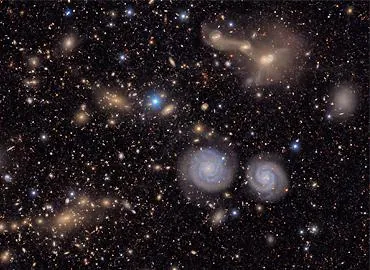
Astronomers at U of T Are on the Edge of a Galactic Discovery with the Vera C. Rubin Observatory
2025-07-07
Author: Emma
A Revolutionary Leap in Astronomy
On June 23, the Vera C. Rubin Observatory unveiled its inaugural images, showcasing the universe through the largest camera in existence, mounted on the 8.4-meter Simonyi Survey Telescope located in the majestic Cerro Pachón, Chile.
These stunning visuals mark the commencement of the groundbreaking 10-year Legacy Survey of Space and Time (LSST), a project set to create a breathtaking ultra-wide, ultra-high-definition time-lapse sky map of the cosmos. This monumental endeavor will enable astronomers and astrophysicists worldwide to probe billions of stars, galaxies, and solar system objects.
Unmatched Detection Capabilities
The observatory's astonishing sensitivity promises to transform our understanding of the universe, with the ability to spot a remarkable 10,000 new celestial objects each night. Within just a year of operation, it's projected that astronomers will uncover more asteroids than have been identified by all previous telescopes combined!
Honoring a Pioneer
This revolutionary observatory is named after Professor Vera C. Rubin, a trailblazer in astronomy renowned for her pivotal findings on dark matter. Her research provided the first significant evidence that dark matter contributes to the mass of galaxies that we cannot directly observe.
Canada's Key Role in the Initiative
The Rubin Observatory is a collaborative project between the U.S. and Chile, with nations, including Canada, contributing computational resources, observing time, and personnel, gaining data rights in return. Canadian researchers and students have secured access through partnerships, constructing vital infrastructure to utilize these rich datasets.
Supported by the National Research Council's data archive and infrastructure from the University of Waterloo and the Dunlap Institute for Astronomy & Astrophysics, Canadian scientists are already brimming with excitement to dive into the intricate details that Rubin's data will unveil.
Canadian Astronomers Poised for Discovery
Among those ready to explore the wealth of data is Professor Maria Drout, recipient of the 2024 Newton Lacy Pierce Prize, who aims to use the rapid observations from Rubin to investigate cosmic transients and stellar explosions alongside Canadian Rubin Fellow Tobias Géron.
Professor Renée Hložek, leading a significant collaboration to study dark energy, will leverage data from Rubin investigating cosmic evolution. She is joined by Faculty Fellow Tanveer Karim, who will focus on Lyman-Break Galaxies to better understand the universe's genesis.
Professor Gwendolyn Eadie plans to explore the outer halo of our galaxy using distant RR Lyrae stars discovered by Rubin, applying advanced statistical techniques to her research. Moreover, Professor Ting Li is set to search for elusive dwarf galaxies and stellar streams within the Milky Way's halo.
Broadening Horizons with AI and Public Engagement
Chair of the David A. Dunlap Department of Astronomy & Astrophysics, Professor Bob Abraham, alongside 2022 Polanyi Prize winner Professor Josh Speagle, aims to understand galaxy evolution utilizing Rubin's imaging data. This collaboration will also explore dark matter and dark energy's enigmatic roles.
Speagle’s team is applying artificial intelligence methods to analyze the wealth of information uncovered by Rubin, sharing images on the Zooniverse platform, inviting public participation in this astronomical quest. Together, they aim to blend advanced technology with citizen science to unveil the universe’s secrets.
A New Era for Astronomy
As these astronomers eagerly await their first data from the Rubin Observatory, the excitement builds for what discoveries await—pushing the boundaries of our cosmic knowledge and revealing the mysteries of the universe that have long eluded us.









 Brasil (PT)
Brasil (PT)
 Canada (EN)
Canada (EN)
 Chile (ES)
Chile (ES)
 Česko (CS)
Česko (CS)
 대한민국 (KO)
대한민국 (KO)
 España (ES)
España (ES)
 France (FR)
France (FR)
 Hong Kong (EN)
Hong Kong (EN)
 Italia (IT)
Italia (IT)
 日本 (JA)
日本 (JA)
 Magyarország (HU)
Magyarország (HU)
 Norge (NO)
Norge (NO)
 Polska (PL)
Polska (PL)
 Schweiz (DE)
Schweiz (DE)
 Singapore (EN)
Singapore (EN)
 Sverige (SV)
Sverige (SV)
 Suomi (FI)
Suomi (FI)
 Türkiye (TR)
Türkiye (TR)
 الإمارات العربية المتحدة (AR)
الإمارات العربية المتحدة (AR)